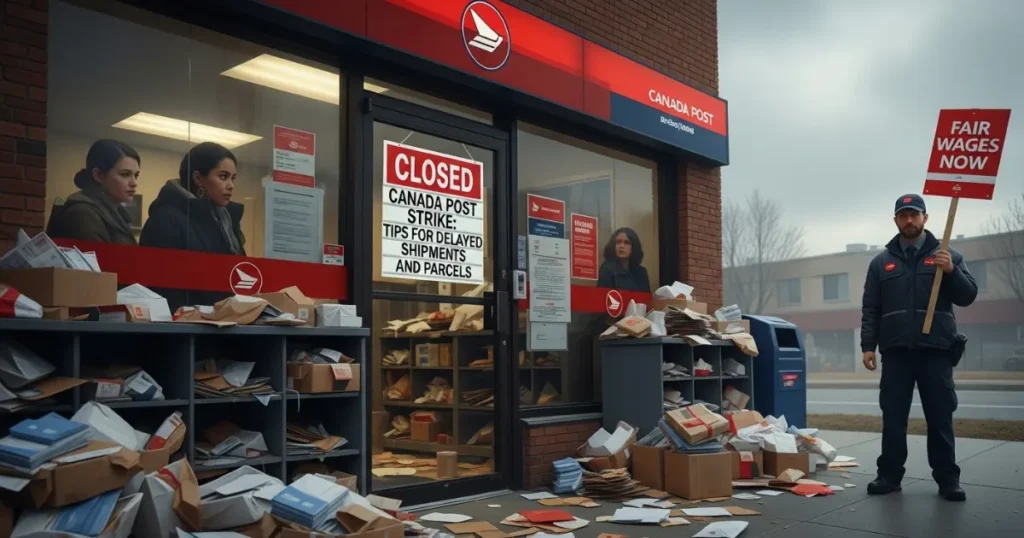The Canada Post strike has emerged as more than a labour dispute—it’s now a tangible disruption to everyday life and business in Canada. With parcels and letters piling up, businesses scrambling for alternatives, and countless shoppers left waiting, the strike demands attention. In this article we cover what the strike means for delayed shipments and parcels, how it impacts you, and what practical steps you can take to soften the blow.
Canada Post Strike: What’s Going On
To understand the current situation, let’s unpack the Canada Post strike. The Canadian Union of Postal Workers (CUPW) has been engaged in extended negotiations with Canada Post Corporation, covering both urban and Rural & Suburban Mail Carriers (RSMC). The ongoing dispute centers on wages, benefits, job security, and evolving delivery models.
In November 2024, a national strike began, lasting until mid-December, and even after services resumed, the disruptions continued to echo across the system. More recently, in 2025, the potential for further stoppages has kept businesses and consumers on alert.
Given this context, it’s unsurprising that parcels and shipments are being delayed. The system is strained, backlogged, and vulnerable. Every day of disruption adds more uncertainty for senders and recipients alike.
Canada Post Strike: How You Might Be Affected
If you are waiting for a parcel, sending products to a customer, or relying on mail-based services, here’s how the Canada Post strike may impact you:
-
Delayed delivery times: With labour actions such as overtime bans or slower operational throughput, parcels and letters may sit longer than usual.
-
Missed deadlines: Bill payments, official documents, passport renewals and gifts may all face delays. For instance, one report noted that the strike caused passport delivery and gift timelines to slip.
-
Business impacts: Small and medium businesses that rely on timely shipping or receiving are finding the strain severe. The Canadian Federation of Independent Business (CFIB) estimates significant losses tied to the stoppage.
-
Switching carriers: Because of uncertainty, many shippers and businesses are turning away from Canada Post to private couriers or alternate delivery methods.
-
Rural and remote impact: Those living in less-accessible areas may experience longer delays, because logistics there rely more heavily on Canada Post’s infrastructure.
In short: if you’re sending or expecting parcels, plan for longer timelines and possible contingencies.
Canada Post Strike: Why Shipments and Parcels Suffer
Understanding why parcels and shipments are delayed helps you plan better. Here are the main reasons:
Labour-related disruptions
The core of the strike is labour. When workers slow down, ban overtime or strike outright, throughput drops. The system becomes slower. For example, after the overtime ban, reports indicated mail carriers would return after eight hours regardless of route completion.
Backlog accumulation
Delays compound quickly. When a backlog builds, even when operations resume “normally,” catching up takes days if not weeks. The November-December 2024 stoppage by Canada Post left many parcels un-delivered for extended time.
Shippers diverting shipments
When businesses anticipate delays, they shift shipments to alternative carriers. This reduces volume for Canada Post but also weakens reliability. According to industry commentary, this may cause long-term customer loss.
Peak-season and e-commerce pressure
E-commerce continues to grow, increasing parcel volumes while letter mail declines. Canada Post is grappling with more parcels and fewer resources, meaning any strike or slowdown hits harder.
Geographic and logistic complexity
Especially for remote or rural locations, Canada Post remains crucial. Disruptions there can be especially long, and alternate carriers may not serve those zones as reliably.
Canada Post Strike: Tips for Managing Delayed Shipments and Parcels
So what can you do if you face delays or need to send something critical? These practical tips will help you navigate the disruption:
1. Start early and set expectations
When sending parcels, assume extra days for delivery. Communicate to recipients that delays may occur due to the strike. Better to under-promise and over-deliver than the reverse.
2. Choose reliable tracking and insured delivery
Use services that offer tracking, proof of delivery and insurance. If your shipment is critical—legal documents, business goods, gifts—these features matter more now.
3. Consider alternate carriers
If you’re a business or sending time-sensitive parcels, consider private courier options (e.g., FedEx, UPS, regional services). Though costlier, they may offer better reliability during a Canada Post strike.
4. Use local drop-off or pick-up options
If possible, drop parcels at courier hubs rather than relying on slow pickups. For incoming parcels, enable notifications so you can pick up from lockers or post offices quickly.
5. Track and monitor shipments
Keep close tabs on the tracking status of your parcels. If a delay is flagged, follow up proactively with your carrier or sender.
6. Communicate with stakeholders
If you’re a business, proactively alert customers of possible delays. If you’re waiting for something, reach out to the sender or postal service. Transparency helps maintain trust.
7. Prioritise key shipments
Identify which parcels must arrive promptly. Send those via premium services, and reserve slower or less critical items for standard shipping.
8. Update your shipping data
Make sure addresses, postal codes, and contact info are correct. Errors compound delays. Also confirm whether the parcel requires signature or holds at the post office.
9. Leverage your own shipment buffers
If you regularly ship items (for business or personal use), build in extra lead-time. Ship earlier than usual for holiday season, gift-giving or business inventory.
10. Keep proof of dispatch
For legal or business shipments, retain proof of dispatch. If a parcel is delayed or lost, documentation will help with claims or customer complaints.
Canada Post Strike: Tips for Recipients Waiting for Parcels
If you’re on the receiving end—waiting for something—here are things you can do:
-
Check tracking regularly: If there’s no movement, reach out to the sender.
-
Allow for extra days: The strike means usual timelines may not apply.
-
Opt-in for notifications: Many services let you know when a parcel will arrive or be held.
-
Pick up quickly: If a parcel is held at a post office or locker, retrieve it promptly—delays in pickup can add further time.
-
Be flexible: If possible, accept delivery at alternative address, or ask a neighbour to sign.
-
Avoid scheduling late delivery for time-sensitive items: If the parcel is required by a specific date, consider re-sending via expedited service.
-
Manage expectations: Communicate with whoever is sending the item that the strike may cause delays.
-
Check with sender for alternate options: Ask whether they can reroute or resend via a different carrier.
-
Document any issues: If your parcel is significantly delayed or lost, document the tracking and communications in case you need to claim compensation.
-
Stay updated on strike developments: The status of the Canada Post strike can change—when services resume fully, delays may reduce. Knowing the timeline helps you plan.
Canada Post Strike: What to Watch Going Forward
While managing current delays is crucial, staying alert to the evolving situation helps you anticipate future disruptions and plan accordingly.
Negotiation progress
Keep tabs on updates from Canada Post and CUPW—such as strike notices, overtime bans, or lockouts. For example, Canada Post recently reported receiving strike notices and indicated that service delays may persist.
Seasonal stress periods
Peak delivery periods—such as the holiday shipping season—are especially vulnerable. The 2024 strike occurred during a key period and had outsized impact.
Shift in shipping behaviour
The strike appears to be accelerating the migration of business and consumers away from Canada Post to private carriers. That creates a structural shift in how parcels are shipped in Canada.
Long-term effects
Persistent disruptions may lead to smaller parcel share for Canada Post, changes in pricing or service models, and more prominent use of courier services. The cumulative effect of delays could reshape Canada’s parcel delivery landscape.
Since Canada Post is a Crown corporation and the dispute has national implications, regulatory or government-mandated
Conclusion
The Canada Post strike isn’t just a headline—it has real implications for anyone sending or receiving parcels, from individuals to businesses. Delayed shipments, held-up parcels, and missed deadlines are becoming part of the new normal in this disruption. But you don’t have to be helpless.
By following the practical tips outlined—starting early, choosing alternate carriers, tracking shipments, communicating effectively, and staying informed—you can minimise the risk and navigate the turbulence with greater confidence. Stay proactive, stay flexible, and keep your shipments moving despite the strike obstacles. Ultimately, making informed choices now will save time, money and frustration down the line.



